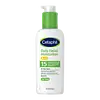What's inside
What's inside
 Key Ingredients
Key Ingredients

 Benefits
Benefits

 Concerns
Concerns

 Ingredients Side-by-side
Ingredients Side-by-side

Aloe Barbadensis Leaf Juice Powder
Skin ConditioningWater
Skin ConditioningButyloctyl Salicylate
Skin ConditioningCetearyl Olivate
Cetyl Alcohol
EmollientSorbitan Olivate
EmulsifyingGlyceryl Stearate
EmollientPotassium Azeloyl Diglycinate
Skin ConditioningGlycerin
HumectantNiacinamide
SmoothingPolyglyceryl-10 Laurate
Skin ConditioningSilica
AbrasivePhenoxyethanol
PreservativeCaprylyl Glycol
EmollientDimethicone
EmollientSodium Stearoyl Glutamate
CleansingOctocrylene
UV AbsorberEthylhexyl Salicylate
UV AbsorberHydroxyethyl Urea
HumectantSodium Acrylate/Sodium Acryloyldimethyl Taurate Copolymer
Emulsion StabilisingEthyl Ferulate
AntioxidantAloe Barbadensis Leaf Juice Powder, Water, Butyloctyl Salicylate, Cetearyl Olivate, Cetyl Alcohol, Sorbitan Olivate, Glyceryl Stearate, Potassium Azeloyl Diglycinate, Glycerin, Niacinamide, Polyglyceryl-10 Laurate, Silica, Phenoxyethanol, Caprylyl Glycol, Dimethicone, Sodium Stearoyl Glutamate, Octocrylene, Ethylhexyl Salicylate, Hydroxyethyl Urea, Sodium Acrylate/Sodium Acryloyldimethyl Taurate Copolymer, Ethyl Ferulate
Butyl Methoxydibenzoylmethane 3%
UV AbsorberOctocrylene 10%
UV AbsorberWater
Skin ConditioningDiisopropyl Adipate
EmollientCyclomethicone
EmollientGlycerin
HumectantGlyceryl Stearate
EmollientPEG-100 Stearate
Polymethyl Methacrylate
Phenoxyethanol
PreservativeBenzyl Alcohol
PerfumingAcrylates/C10-30 Alkyl Acrylate Crosspolymer
Emulsion StabilisingTocopheryl Acetate
AntioxidantCarbomer
Emulsion StabilisingDisodium EDTA
Triethanolamine
BufferingButyl Methoxydibenzoylmethane 3%, Octocrylene 10%, Water, Diisopropyl Adipate, Cyclomethicone, Glycerin, Glyceryl Stearate, PEG-100 Stearate, Polymethyl Methacrylate, Phenoxyethanol, Benzyl Alcohol, Acrylates/C10-30 Alkyl Acrylate Crosspolymer, Tocopheryl Acetate, Carbomer, Disodium EDTA, Triethanolamine
Ingredients Explained
These ingredients are found in both products.
Ingredients higher up in an ingredient list are typically present in a larger amount.
Glycerin is already naturally found in your skin. It helps moisturize and protect your skin.
A study from 2016 found glycerin to be more effective as a humectant than AHAs and hyaluronic acid.
As a humectant, it helps the skin stay hydrated by pulling moisture to your skin. The low molecular weight of glycerin allows it to pull moisture into the deeper layers of your skin.
Hydrated skin improves your skin barrier; Your skin barrier helps protect against irritants and bacteria.
Glycerin has also been found to have antimicrobial and antiviral properties. Due to these properties, glycerin is often used in wound and burn treatments.
In cosmetics, glycerin is usually derived from plants such as soybean or palm. However, it can also be sourced from animals, such as tallow or animal fat.
This ingredient is organic, colorless, odorless, and non-toxic.
Glycerin is the name for this ingredient in American English. British English uses Glycerol/Glycerine.
Learn more about GlycerinGlyceryl Stearate is a mix of glycerin and stearic acid.
It is used to stabilize the mixing of water and oil ingredients. By preventing these ingredients from separating, it can help elongate shelf life. It can also help thicken the product's texture.
As an emollient, it helps soften skin and supports barrier-replenishing ingredients.
In cosmetics, Glyceryl Stearate is often made from vegetable oils or synthetically produced.
This ingredient may not be fungal-acne safe
Fun fact: The human body also creates Glyceryl Stearate naturally.
Learn more about Glyceryl StearateOctocrylene protects skin from sun damage. It absorbs UV-B with peak absorption of 304 nm. It is a common sunscreen ingredient and often paired with avobenzone, a UVA filter. This is because octocrylene stabilizes other sunscreen ingredients by protecting them from degradation when exposed to sunlight. Octocrylene is a photostable ingredient and loses about 10% of SPF in 95 minutes.
Octocrylene also acts as an emollient, meaning it helps skin retain moisture and softens skin. It is oil-soluble and hydrophobic, enhancing water-resistant properties in a product.
Those who are using ketoprofen, a topical anti-inflammatory drug, may experience an allergic reaction when using octocrylene. It is best to speak with a healthcare professional about using sunscreens with octocrylene.
The EU allows a maximum of these concentrations:
Learn more about OctocrylenePhenoxyethanol is a preservative that has germicide, antimicrobial, and aromatic properties. Studies show that phenoxyethanol can prevent microbial growth. By itself, it has a scent that is similar to that of a rose.
It's often used in formulations along with Caprylyl Glycol to preserve the shelf life of products.
Water. It's the most common cosmetic ingredient of all. You'll usually see it at the top of ingredient lists, meaning that it makes up the largest part of the product.
So why is it so popular? Water most often acts as a solvent - this means that it helps dissolve other ingredients into the formulation.
You'll also recognize water as that liquid we all need to stay alive. If you see this, drink a glass of water. Stay hydrated!
Learn more about Water